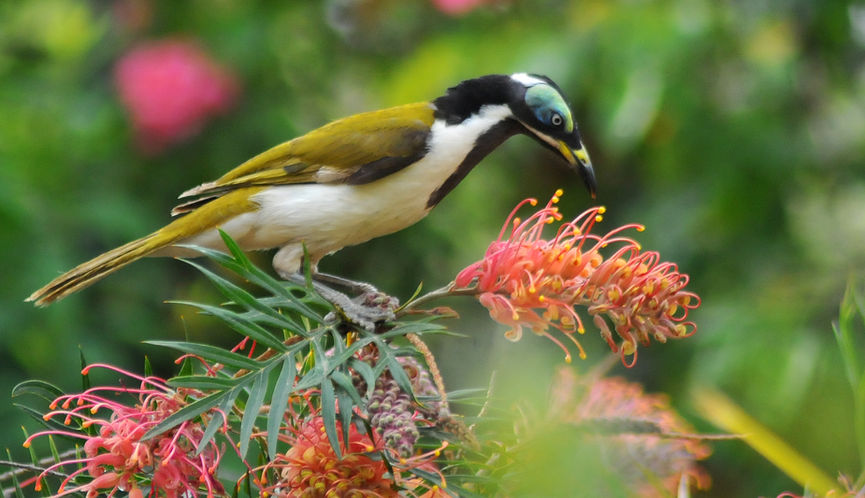Blue-faced Honeyeater
Entomyzon cyanotis
Quick facts
Other names: Banana Bird (due to its liking for banana flowers), Pandanus Bird.
Size: Similar to Rainbow Lorikeet and Magpie-Lark.
Range and lifestyle: Resident throughout northern and eastern Australia.
Food: Insects, nectar and fruit.
Breeding: Mostly winter and spring. The nest is bulky bowl of bark and grass often at the base of palm fronds. Clutch is 2-3 eggs, pinkish with blotches of brown and purple, incubated by the female alone, while the chicks are fed by all group members.
One of the largest members of the honeyeater family, the Blue-faced Honeyeater is a very social bird, usually found in clans of 4 to 10 birds that live year-round in large territories. Sometimes these clans meet each other, and a noisy battle will erupt with up to 20 birds squabbling in the air.
Only adults 2 or more years of age have the 2-tone blue faces. Babies have yellow faces, and after 6 months this turns olive-green, but gradually becomes bluer.
Despite being a member of the Honeyeater family (Meliphagidae), most of their diet consists of insects – their long, sticky tongues help them catch insects as well as gather nectar and pollen.
They're also one of the few Aussie birds with the nasty habit of taking over nests of other species instead of building their own nests. Most Blue-faced Honeyeaters nests are attended by 1-3 helpers in addition to the breeding pair - usually offspring from previous years. Pairs may not be successful in raising young without these helpers. Their nests are often built at the base of palm tree fronds, where they are well hidden from predators.
The Blue-faced Honeyeater is one of the dozen or so bird species who are able to live inside Noisy Miner territories. This is probably because it is larger than the miner, and just as bold and aggressive. The two species sometimes argue with each other over food, but at other times, they work together to attack and chase off predatory birds and other animals.
Text © Richard Noske 2019 CC BY-NC-SA
Audio
Photo gallery
Video gallery
References
Kazuhiro Eguchi, Noriyuki Yamaguchi, Keisuke Ueda & Richard A. Noske. (2013). The effects of nest usurpation and other interference by the Blue-faced Honeyeater on the reproductive success of the Grey-crowned Babbler. Emu - Austral Ornithology, 113:1, 77-83, DOI: 10.1071/MU12044



















